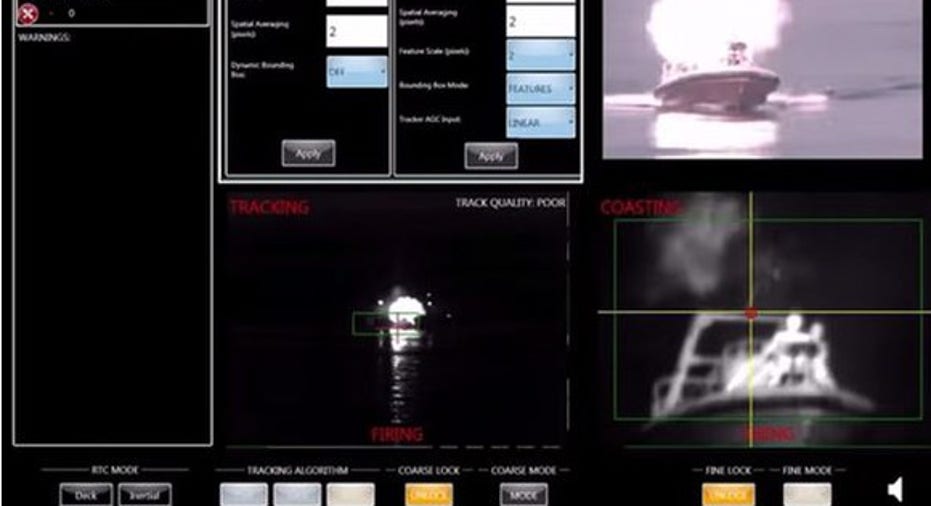Britain Will Build a Laser Cannon

It's been nearly three years since the U.S. Navy fielded its first operable laser cannon aboard a warship at sea -- a 33-kilowatt, $40 million Laser Weapon System (LaWS). Since then, the Navy's ambitions have only gotten bigger.
Last year, the Navy hired Northrop Grumman (NYSE: NOC) to build it a more advanced Laser Weapon System Demonstrator (LWSD) that can crank out five times the kilowatts (150 kW) of LaWS and shoot down cruise missiles several miles distant. With every passing day, the U.S. Navy is moving toward a laser-armed future.
And now, Britain's Royal Navy wants laser weapons, too.
What looks like a video game, works like a flashlight, and explodes targetswith a "bang"? Answer: The U.S. Navy's Laser Weapon System (LaWS). VIDEO STILL:U.S. NAVY.
Getting the band together
As reported in the International Business Times last week, Britain has assembled its best and brightest defense contractors into a "Dragonfire consortium." It's mission: to build a laser cannon for the British Ministry of Defence (MoD).
Armed with an initial $36.5 million contract, Airbus (NASDAQOTH: EADSY) subsidiary MBDA, BAE Systems (NASDAQOTH: BAESY), QinetiQ (LSE: QQ), Leonardo (NASDAQOTH: FINMY), and privately held Arke will attempt to build a laser "demonstrator." In its first iteration, this demo-version laser will only track (but not destroy) practice targets. If all goes well with that, MoD may extend the project and try to build an actual Laser Directed Energy Weapon (LDEW), one capable of shooting down hostile drones and missiles. That accomplished, the next step would be to build production versions of the LDEW, and roll them out "across the UK military."
What it means to investors
$36.5 million may not sound like a lot of money, but according to IBT, the Ministry of Defence has nearly $1 billion available in its "Innovation Fund," which can be deployed to accelerate the development of laser weapons if initial tests prove promising. While not all of these funds will be earmarked for laser development, there should be ample funding for the R&D stage, and for Airbus, BAE, QinetiQ, Leonardo, and Arke to conduct it. And what about further out, after LDEW leaves the development stage and the MoD begins installing laser cannons on its warships?
The size of that opportunity is hard to estimate. With just 60-odd warships in its fleet, Britain's Royal Navy is much smaller than that of its U.S. ally. Still, 60 times the estimated $30 million to $40 million cost of a prototype laser weapon -- times the potential for multiple laser cannon being installed upon each individual warship -- still makes for a sizable revenue opportunity for these defense contractors.
Add to this the potential for laser weapons on airplanes, lasers on armored vehicles, and even laser cannon being toted around by infantry platoons, and the opportunities for Britain's defense contractors to rack up big revenues, and big profits from the laser revolution, should be clear.
10 stocks we like better than Northrop Grumman When investing geniuses David and Tom Gardner have a stock tip, it can pay to listen. After all, the newsletter they have run for over a decade, Motley Fool Stock Advisor, has tripled the market.*
David and Tom just revealed what they believe are the 10 best stocks for investors to buy right now...and Northrop Grumman wasn't one of them! That's right -- they think these 10 stocks are even better buys.
Click here to learn about these picks!
*Stock Advisor returns as of January 4, 2017.
Rich Smith has no position in any stocks mentioned. The Motley Fool has no position in any of the stocks mentioned. The Motley Fool has a disclosure policy.



















